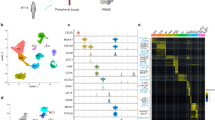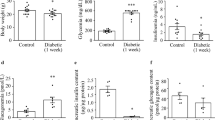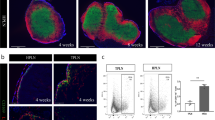Abstract
CHICKENS of the Obese strain (OS) spontaneously develop severe autoimmune thyroiditis during the first weeks of life, with clinical signs of hypothyroidism1,2. Serological tests reveal both circulating and bound thyroglobulin autoantibodies3. The lymphoid infiltration of the thyroid gland is characterised by a predominance of plasma cells and the formation of a large number of germinal centres1. In view of the histological and serological features, the spontaneous autoimmune thyroiditis of OS chickens can be considered as an appropriate animal model for human Hashimoto thyroiditis2.
This is a preview of subscription content, access via your institution
Access options
Subscribe to this journal
Receive 51 print issues and online access
$199.00 per year
only $3.90 per issue
Buy this article
- Purchase on Springer Link
- Instant access to full article PDF
Prices may be subject to local taxes which are calculated during checkout
Similar content being viewed by others
References
Cole, R. K., Kite, J. H., jun., and Witebsky, E., Science, 160, 1357 (1968).
Wick, G., Sundick, R. S., and Albini, B., Clin. Immun. Immunopath., (in the press).
Wick, G., Witebsky, E., Kite, J. H., jun., and Beutner, E. H., Clin. exp. Immun., 7, 173 (1970).
Witebsky, E., Kite, J. H., jun., Wick, G., and Cole, R. K., J. Immun., 193, 708 (1969).
Sundick, R. S., and Wick, G., Gen. comp. Endocr. (in the press).
Wick, G., Clin. exp. Immun., 7, 187 (1970).
Albini, B., and Wick, G., Immunology, 21, 957 (1971).
Wick, G., Kite, J. H., jun., Cole, R. K., and Witebsky, E., J. Immun., 104, 45 (1970).
Albini, B., and Wick, G., Immunology, 24, 545 (1973).
Wick, G., and Steiner, R., J. Immun., 109, 471 (1972).
Wick, G., and Albini, B., in Immunopathology, 7th Int. Symp., (edit. by Miescher, P. A.) (in the press).
Wick, G., Albini, B., and Milgrom, F., Clin. exp. Immun., 15, 237 (1973).
Albini, B., and Wick, G., Int. Arch. Allergy, 44, 804 (1973).
Möller, G., J. exp. Med., 114, 415 (1961).
Albini, B., and Wick, G., J. Immun., 112, 444 (1974).
Stobo, J. D., Talal, N., and Paul, W. E., J. Immun., 109, 701 (1972).
Waksman, B. H., Raff, M. C., and East, J., Clin. exp. Immun., 11, 1 (1972).
Wick, G., and Witebsky, E., Int. Arch. Allergy, 40, 603 (1971).
Chused, T. M., Hardin, J. A., Frank, M. M., and Green, I., J. Immun., 112, 641 (1974).
Author information
Authors and Affiliations
Rights and permissions
About this article
Cite this article
ALBINI, B., WICK, G. Proportional increase of bursa-derived cells in chickens of the Obese strain. Nature 249, 653–654 (1974). https://doi.org/10.1038/249653a0
Received:
Revised:
Issue Date:
DOI: https://doi.org/10.1038/249653a0
This article is cited by
Comments
By submitting a comment you agree to abide by our Terms and Community Guidelines. If you find something abusive or that does not comply with our terms or guidelines please flag it as inappropriate.



